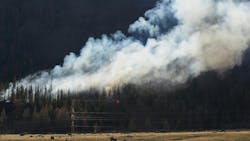How Geospatial Intelligence Is Quietly Changing the Way We Manage Utility Risks
If you’ve worked in or around utilities for a while, you’ve probably noticed a shift. Wildfires, once a seasonal worry, now feel like a year-round threat. And the ways we’ve traditionally tried to keep infrastructure safe—from vegetation management to inspections—just aren’t cutting it anymore. Not because they’re wrong, but because the environment we’re operating in has changed so drastically.
The truth is, field crews still play a vital role. But when you’re managing thousands of miles of lines and poles across large regions, there’s only so much you can catch with boots on the ground. The scale is just too massive, and the risks are getting harder to predict.
Why the Old Playbook Doesn’t Work Anymore
A lot of utility networks today cover enormous stretches of land, often through tough terrain. You’ve got vegetation creeping in, weather patterns shifting, and new risks popping up faster than schedules can keep up with. Relying only on routine inspections and reacting to problems after they surface has become more of a gamble than a plan.
That’s what’s pushing many utilities to look for better ways to stay ahead—tools that can provide more than just more data, but the kind of insight that helps you make decisions before something breaks.
Where LiDAR, Imagery, and GIS Step In
What’s catching on is the combination of LiDAR, high-res imagery, and GIS. On their own, each of these is powerful. Together, they paint a much clearer picture of what’s really happening on the ground—or in the trees, or along the lines.
Instead of relying on gut checks or waiting for something to go wrong, these tools let utilities actually see where risks are forming and step in early. It’s not magic, it’s just smarter use of tech that’s been around for a while but is finally being put to work in ways that matter.
Turning All That Data into Action
One thing that often gets overlooked is how all this information gets used. It’s not just about collecting it and dumping it in a report. The real benefit shows up when insights from LiDAR and GIS are actually baked into how teams work every day.
Some setups now process huge volumes of line data to figure out exactly where the vegetation risks are and then feed that straight into the crews’ workflow. It cuts down on the guesswork, speeds up planning, and helps people focus where it counts.
This isn’t just a nice upgrade. It’s a full-on shift in how operations are being handled.
From Putting Out Fires to Preventing Them
What’s even more interesting is how this changes the way teams think. Instead of waiting for a problem to pop up and scrambling to fix it, more organizations are now planning and avoiding the issue entirely.
Maps used to be just that maps. Now, GIS platforms are more like real-time dashboards that guide where resources go and when. It’s turning fieldwork into something more strategic and far less reactive.
The Big Takeaway? You Need to See It to Protect It
If there’s one thing this all comes down to, it’s visibility. You can’t manage what you can’t see. And in a world where risks are getting harder to pin down, seeing clearly is half the battle.
Geospatial intelligence doesn’t just give utilities a new toolset. It offers a new mindset. One where clarity, not routine, drives the decisions and that can make all the difference when safety and reliability are on the line.
About the Author
Joel Stevens
Joel Stevens is Utilities Delivery Director at Techwave, North America.
